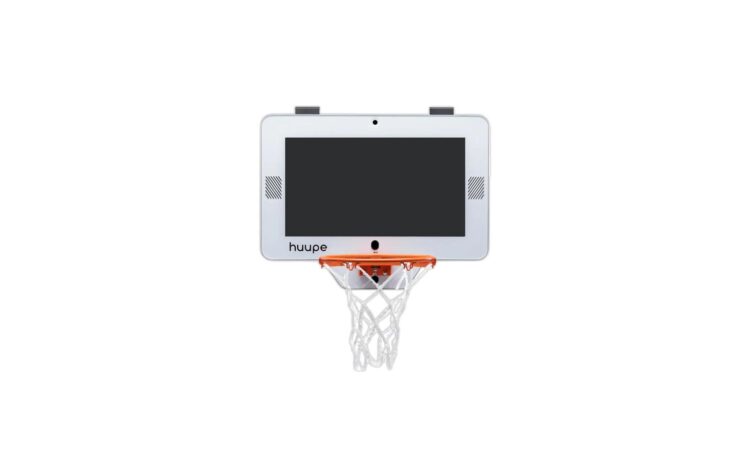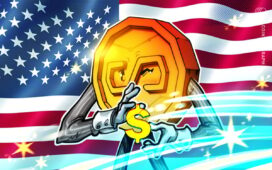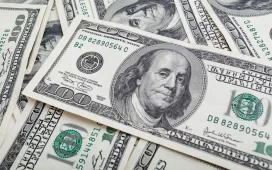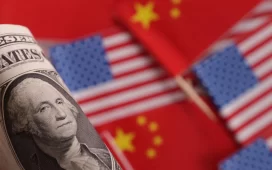A photo of the ‘Huupe’ hoop, an AI gaming and training device.
For 134 years, basketball remained largely untouched by technology—until two childhood friends, Paul Anton, and Lyth Saeed, were separated by thousands of miles after going away to college.
“We still wanted to play the game together,” Anton says in a phone interview. “But all we could do was compete on Snapchat, sending each other clips of our shots.”
The social media back-and-forth sparked a bigger idea: What if a basketball hoop could enable real-time virtual play, track player shots, and analyze mechanics? This question led them to create the “smart” basketball hoop startup Huupe.
After several years and prototypes, the pair had a patented system: an interactive basketball backboard that uses a combination of sensors, imaging devices, and a control unit to analyze a user’s basketball shots and provide real-time feedback.
Excitement From NBA Insiders
Sports Business Journal first reported in September 2023 that NBA veterans Thaddeus Young, formerly of the Phoenix Suns, now head of Reform Ventures, Trevor Booker, formerly of the Indiana Pacers and now a partner at the JBFitzgerald Group, and Milwaukee Bucks Co-Owner Keith Mardak backed Huupe.
All are confident about its potential.
“Huupe is going to be one of the best-selling gaming consoles of the next decade,” he tells me via phone. “It connects kids to physical activity while keeping them engaged digitally.” Booker, also an investor in Huupe, echoes that optimism via email: “Huupe will be a billion-dollar company one day. That’s why I invested.” Mardak is just as optimistic. “Huupe could add $1 billion in value to the basketball and gaming industry.”
Meanwhile, Dan Costello, the Phoenix Suns’ Chief Revenue Officer, calls Huupe a “billion-dollar disruptor.” Costello has no financial interest in the company.
Aristotle Loumis, director of the board, points out that “they embarked on this journey well before AI became a buzzword. While others chased trends, Huupe was perfecting the seamless integration of AI into one of the world’s most beloved sports.”
AI Optimism Is Everywhere
Nor is it limited to Huupe.
According to a February 2025 report from The National Law Review, “nearly 33% of all global venture funding was directed to AI companies” last year.
Huupe’s approach reflects a broader boom in AI-powered sports analytics.
For instance, a March 2024 study in Nature Communications details a project called TacticAI, co-developed by Liverpool FC and Google DeepMind. Together, they used geometric deep learning to evaluate corner-kick tactics.
Liverpool’s coaching staff favored TacticAI’s revised strategies 90% of the time—illustrating how AI can boost decision-making at the elite level.
Huupe aims to make similarly data-driven insights available on a home court. “The future of sports isn’t just about watching highlights—it’s about interactive, real-time competition with anyone, anywhere,” Saeed says via phone.
Tension Between Technology and Tradition
In September 2024, Nicole Rosenthal of The New York Post covered several players’ interactions with the Huupe at Tompkins Square Park in Manhattan.
Sebastian Blank, an “old-school” athlete, said: “The technology gets in my head. You focus on making mistakes instead of just seeing what happens.”
David Almog, lead author of the 2024 paper, “AI Oversight and Human Mistakes: Evidence from Centre Court,” wrote that AI interplay with sports can “introduce new behavioral forces into play.” So Blank isn’t wrong per se.
In a November 2024 article published in the Communications of the Association for Computing Machinery, Daniel Martin, an associate professor of economics at the University of California at Santa Barbara, spoke about the MLB and Hawk-Eye, a strike zone monitoring AI.
Therein, Martin says the system is “incredibly accurate” but that “there’s something deeply appealing about the human element [in a game]” and “that people like people in the mix.”
Imperfect calls are a part of it. Some may prefer the spontaneity of a purely organic game. Could the real-time feedback detract from basketball’s free-flowing nature?
But Anton and Saeed stress they’re not out to replace traditional basketball but to enrich the experience with more advanced training tools–and gaming.
Cost is another factor.
Huupe’s early prototypes cost five figures and required professional installation. History shows early innovations aren’t cheap. Geoffrey Morrison of CNET, for example, reported that Phillips/Fujitsu flat-panel TVs cost $22,000 in 1997. Now a 50″ LED is $200.
In time, the company introduced the Huupe Mini at $599, but critics on social media still said it’s pricey. The Huupe Mini is comparable to today’s major gaming consoles, such as PlayStation 5 Pro ($699) or Xbox Series X ($499).
The Huupe Mini sold out online and via all retailers like Best Buy, per the company, and this sellout validates that some consumers see the value in Huupe’s technology, proving that quality and innovation can outweigh price objections.
Broader market signals for AI-driven innovation suggest a rising demand for interactive gaming. For instance, on February 6, 2025, India’s Ministry of Electronics and Information Technology, through its IndiaAI platform, reported that the AI gaming market could reach $27.47B by 2029.
And Huupe’s leadership believes that, as the demand for interactive sports tech grows, the company is uniquely positioned at the intersection of AI, gaming, and athletics. The company is a first-mover advantage, but that advantage begets complexity.
Industry history suggests that once-niche breakthroughs often become standard through economies of scale and broader adoption. So as AI continues to expand its reach, the question is not if or when but who will lead this evolution of basketball.
If you ask many investors and NBA insiders, they’ll say Huupe.





